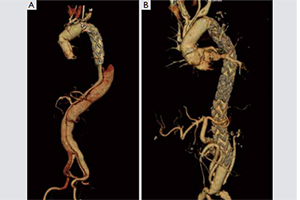Frozen elephant trunk surgery—the Bologna’s experience
Abstract
Background: Different approaches are available to treat patients with complex and extensive diseases of the thoracic aorta. This study aims to report and comment on our experience with the frozen elephant trunk (FET) technique.
Methods: Between January 2007 and July 2012, 122 patients (male: 86.9%; mean age: 61 years) underwent extensive thoracic aorta surgery using the FET approach with an E-vita open prosthesis. The most frequent indications for surgery included residual type A chronic dissection (45.9%), extensive degenerative aneurysm of the thoracic aorta (27%), and type A acute aortic dissection (7.4%). Sixty-nine patients had already undergone cardiac/aortic interventions through a median sternotomy. A total of 60 associated procedures were performed, with 76.6% on the aortic root. Selective antegrade cerebral perfusion and moderate hypothermia were used in all cases.
Results: Overall, hospital mortality was 15.2%. Post-operatively, 7.4% and 9.0% of patients were complicated by permanent neurologic dysfunction and spinal cord injury, respectively. For the surviving patients, 1- and 3-year freedom from all-cause mortality was 91.7±2.8% and 79.1±6.1%, respectively. 1- and 3-year freedom from re-intervention was 83.1±3.5% and 74.1±4.3%, respectively.
Conclusions: In our experience, FET surgery allowed treatment of complex patients with extensive thoracic aortic diseases with satisfactory short- and mid-term results. Acute and chronic dissections represent interesting subsets for FET application. While further larger and longer-term studies are required to show the survival benefits of the FET technique versus other types of management, new strategies for spinal cord injury (paraplegia/paraparesis) reduction should also be researched.
Cover






